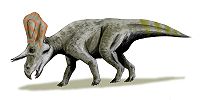
Moreno Hill Formation
Encyclopedia
The Moreno Hill Formation is a geological formation in New Mexico whose strata date back to the Late Cretaceous
. Dinosaur remains are among the fossils that have been recovered from the formation.
Late Cretaceous
The Late Cretaceous is the younger of two epochs into which the Cretaceous period is divided in the geologic timescale. Rock strata from this epoch form the Upper Cretaceous series...
. Dinosaur remains are among the fossils that have been recovered from the formation.
Dinosaurs
| Dinosaur Dinosaur Dinosaurs are a diverse group of animals of the clade and superorder Dinosauria. They were the dominant terrestrial vertebrates for over 160 million years, from the late Triassic period until the end of the Cretaceous , when the Cretaceous–Paleogene extinction event led to the extinction of... s of the Moreno Hill Formation |
||||
|---|---|---|---|---|
| Taxa | Presence | Description | Images | |
Clade:
|
An unnamed small coelurosaur and dromeosaur. |
  |
||
Clade:
|
An basal hadrosauromorph. |
|||
Genus:
|
A therizinosaur Therizinosaur Therizinosaurs are theropod dinosaurs belonging to the clade Therizinosauria. Therizinosaur fossils have been found in Early through Late Cretaceous deposits in Mongolia, the People's Republic of China and Western North America... . "Teeth, fragmentary skull bones, cervical and other vertebrae, scapula, partial forelimb and hindlimb." |
|||
Genus:
|
A ceratopsia Ceratopsia Ceratopsia or Ceratopia is a group of herbivorous, beaked dinosaurs which thrived in what are now North America, Europe, and Asia, during the Cretaceous Period, although ancestral forms lived earlier, in the Jurassic. The earliest known ceratopsian, Yinlong downsi, lived between 161.2 and 155.7... n. "Partial cranial and postcranial materials of five individuals." |
|||

